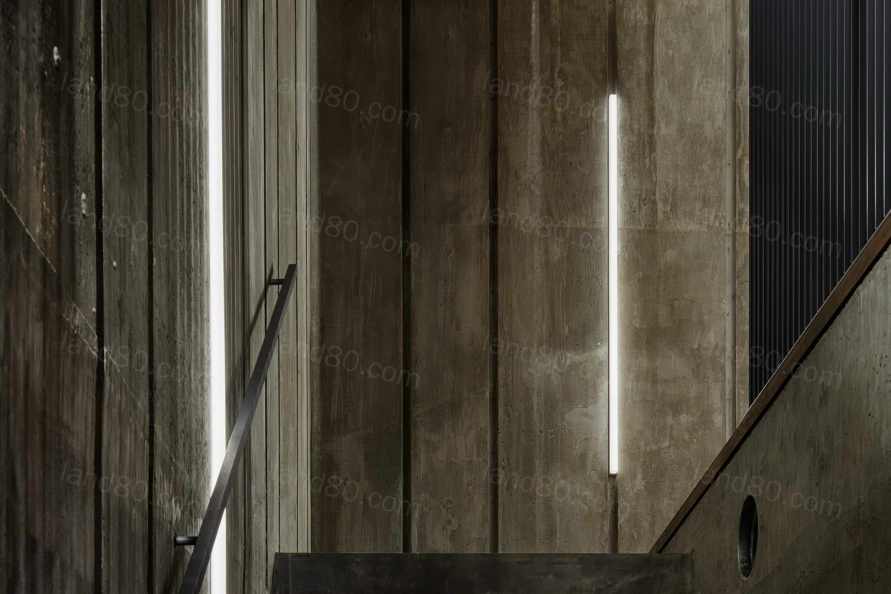该场地位于东京板桥区一个安静的住宅和购物区的长车道尽头。东京,板桥区。 周边地区是一个传统的城镇景观,房屋和小商店高度集中。春天的时候,这里到处都是前来观赏尺牍河畔美丽的樱花树的游客。由于场地的形状和周围环境的原因,建筑的整体形象是场地的形状和周围的环境使整个建筑从外部无法识别,它静静地矗立在后巷中。在策划一个小规模的会员制音乐沙龙的同时,还需要控制噪音。为了在不规则的旗杆场地上创造一个尽可能大的空气容量的大厅空间,主要的空间位于场地的东侧,通往前面道路的方法是自然流向场地的后面。为了创造一个大气量的厅堂空间,将主要空间放在场地的东侧作为 "旗",并将前路的引道作为 "杆",在这里建造了车流自然流向场地的后方。
The site is located at the end of an arcade leading from a quiet residential / shopping district in Itabashi-Ku, Tokyo. The surrounding area is very nostalgic, has many houses and small shops. In springtime, the Shakujii River is filled with people to see Sakura blossom. The architecture shape is formed by the shape of the site and merged into the neighborhood, standing quietly in the back alley. When planning a small membership-based music salon, you need to ensure the sound quality is the same as a large-scale music hall and, set a high noise control for the dense neighborhood. Natural circulation is created with the irregular flagpole-shaped site, entering the space from a “rod” shaped part of the site, and flows into it. The plan was to lift an attached room that integrates various functions such as sound equipment.
古典音乐的空间
在计划这个项目时,我开始问自己一个纯粹的问题:"我想在什么样的空间里听古典音乐?
我从一个纯粹的问题开始计划,答案非常简单:
我想创造 "一个让声音产生良好共鸣的地方,让音乐、表演者和空间成为一体。
乐器有一种普遍的美,我想创造一个地方,让表演者的微妙音调和姿态在这里得到体现。
我在强烈和粗糙的材料基础上组成了这个空间,与表演者的细腻色调和姿态形成对比。
通过这种方式,我的目的是创造一个作为表演背景的空间,在这里,焦点自然是在音乐和表演者身上。 我打算创造一个像乐器一样的现代经典建筑,就像一个乐器,随着时间的推移,会越来越有价值。
A Space for Classic Music
In the planning stage, I often question myself, " What kind of space would I like to listen to classical music?"
And the answer turned out to be quite simple, I would like to make, " Great sound effect, and space where music, musician and space and unite.”
A musical instrument has universal beauty, and it is contrasted with the delicate sound and player's action.
Musical instruments have universal beauty, contrast with delicate tones, and performers' actions. Space was constructed based on powerful and raw materials. The material helps to create a natural focal point on the musician and their performance. Aiming for an instrument-like space, that gets deeper over time; intended for modern classic architecture.




根据声学原理“加减”
主空间是一个无柱的空间,并采用公平的RC墙来保证声音混响的基础。为了在狭小的场地上建造一个尽可能少浪费的空间,我们增加了必要的设施和缓冲区,以改善房间的声学效果并控制噪音。我们考虑到空间的比例,考虑了声学中的硬性和软性以及空间中的硬性和软性之间的平衡。
"Reveal" and "Add" according to the sound.
The main space is designed to be pillar-free with reinforced concrete walls to secure the echo of base sound. Linear space is designed to make good use of the small site, to improve the overall noise control, necessary equipment and buffer zones are also incorporated to space.The space proportion is mixed of hardness and softness, hardness from the architecture, and softness from the sound effect, giving the space a balanced harmony.




通过声学模拟引导的空间比例
对于主音乐沙龙,我们通过声学模拟研究了空间的比例,使声音在整个空间内均匀地产生共鸣,同时在有限的建筑高度内尽可能地保证天花板的高度。 通常情况下,当天花板和地板或墙壁和墙壁平行放置时,会产生飘忽不定的回声,所以我们在堆积了许多形状后决定了空间的比例,使声音在整个空间内均匀地回响。 计划的形状是沿场地尽可能大的不等边方形,在两层的空间上采用方形屋顶。 倾斜的屋顶所创造的上部空间被用作设备空间,同时实现统一的声音。
Proportion of the Space led by Acoustic Simulation
For the main music salon, the proportion of the space is designed based on the acoustic simulation, to ensure that the sound can evenly reverberate throughout the space within the limited building height. Normally, flutter echoes occur when the ceiling, floor, and wall are arranged parallel to one another. To avoid the flutter echo, numerous acoustic panels are added to ensure that the sound can spread evenly throughout. The plan and site are shaped as an irregular quadrilateral, and a square roof is adopted for the double height of space. Achieving a uniform acoustic effect, and is also practical for equipment to be placed under the sloped ceiling.



Project: Maly Koncert
Design Firm: Ryo Otsuka Architects
Project: Tokyo, Japan
Construction: (株)和田建築
Photography: Keiko Chiba / Nacasa and Partners
|